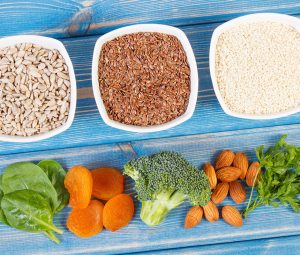The Weight Loss Potential of Calcium
Posted on : September 7, 2023
by Ashleigh Feltham Accredited Practising Dietitian and Accredited Nutritionist

The Weight Loss Potential of Calcium
We know that calcium helps to keep bones strong. The importance of calcium goes beyond strengthening bones, which is important to prevent osteoporosis. Calcium is also needed for normal muscle contractions, regulating your heart rate and promoting normal blood clotting. On top of this, calcium helps enzymes and the nervous system work at their best. Another important role you may not have heard about is that this mighty mineral may help you achieve a healthy weight.
Research is still developing in this area, but it shows the potential for the use of calcium to promote weight loss and also improve health markers like reducing insulin resistance. One study on adolescent boys reported that those with the highest amount of calcium in their diet compared to the lowest had significantly lower body weight and central adiposity. Central adiposity is a factor of importance; this type of fat is centred around the organs and increases your risk of diseases such as heart disease.
Another study investigated the effects of calcium supplementation during a weight loss intervention. This study used a randomised, placebo-controlled model. Research was conducted over 24 weeks on 32 selected obese adults. It was concluded that for weight loss eating in a calorie deficit was the most important factor. Secondary to this, dietary calcium significantly reduced weight, specifically in the trunk region (central adiposity). Out of all the types of calcium-containing foods, dairy made the most significant effect on reducing weight.
Before you reach out for supplements, there are numerous studies that suggest calcium sourced from food, especially from dairy, is more effective at promoting weight loss than from supplements. This could be due to the additional weight loss promoting factors in food such as protein, which helps to promote feelings of satiety.
Calcium assisting in weight loss is predicted to be due to two factors. Firstly, calcium may increase the amount of fat your body excretes, preventing it from being stored as fat. The second is that your fat cells store calcium. When your calcium levels are optimal or high, the regulation process to optimise calcium levels decreases the amount of parathyroid hormone and 1,25-hydroxy vitamin D. Parathyroid hormone and 1,25-hydroxy vitamin D promote storage of any calcium that your body is holding onto, including in your fat cells. Lowering these two factors ultimately leads to an increased use of fat cells.
So, how much dairy or dairy alternatives do you need to meet your calcium needs each day?
 If you are 13-18 years old you need 3.5 servings of dairy or dairy alternatives each day. Women and men aged 18-50 years need 2.5 servings a day.
If you are 13-18 years old you need 3.5 servings of dairy or dairy alternatives each day. Women and men aged 18-50 years need 2.5 servings a day.
Women aged 51 years and over need to increase dairy or dairy alternatives to four servings a day. This is because of the process of menopause and the increased likelihood of developing osteoporosis as hormones change in a woman’s body.
When men reach the age of 71 years, their needs increase to 3.5 serves of dairy or dairy alternatives each day to meet their calcium needs.
What makes up a serving?
- 200g of yoghurt
- 40g of hard cheese
- ½ cup of ricotta or cottage cheese
- ½ cup of evaporated milk
Dairy alternatives to meet your calcium needs include:
- 250ml of fortified soy, rice or other cereal drinks. Look for fortified (or added calcium) of at least 100g per 100ml
- ½ cup of salmon with bones
- 60g sardines
- 100g firm tofu
- 100g almonds

Take home message
If you are struggling to win the battle for sustained weight loss, getting enough calcium each day may be the missing link. Overall calorie deficit is necessary for weight loss, and while calcium is not a magic bullet, it may help put the odds in your favour for success. On top of this, calcium may also reduce your risk of other diseases such as heart disease and type 2 diabetes due to reduced central adiposity and insulin sensitivity.

References:
- Council NHaMR. Nutritient Reference Values Australia and New Zealand Australia: Commonwealth of Australia; 2005 [cited 2015 8/8/2015]
- Australia O. Vitamin D Australia: Osteoporosis Australia; 2014 [updated 2014; cited 2015 10/8/2015].
- Australian guide to healthy eating. Journal of the Home Economics Institute of Australia. 2013;20(1):7.
- Council NHaMR. Nutrient Reference Values Australia and New Zealand Australia: Commonwealth of Australia; 2005 [cited 2015 8/8/2015]
- Jürimäe J, Mäestu E, Mengel E, Remmel L, Purge P, Tillmann V. Association between Dietary Calcium Intake and Adiposity in Male Adolescents. Nutrients. 2019 Jun 27;11(7):1454. doi: 10.3390/nu11071454. PMID: 31252547; PMCID: PMC6682862.
- Shapses SA, Heshka S, Heymsfield SB. Effect of calcium supplementation on weight and fat loss in women. J Clin Endocrinol Metab. 2004 Feb;89(2):632-7. doi: 10.1210/jc.2002-021136. PMID: 14764774; PMCID: PMC4010554.
- Zemel MB, Thompson W, Milstead A, Morris K, Campbell P. Calcium and dairy acceleration of weight and fat loss during energy restriction in obese adults. Obes Res. 2004 Apr;12(4):582-90. doi: 10.1038/oby.2004.67. PMID: 15090625.



